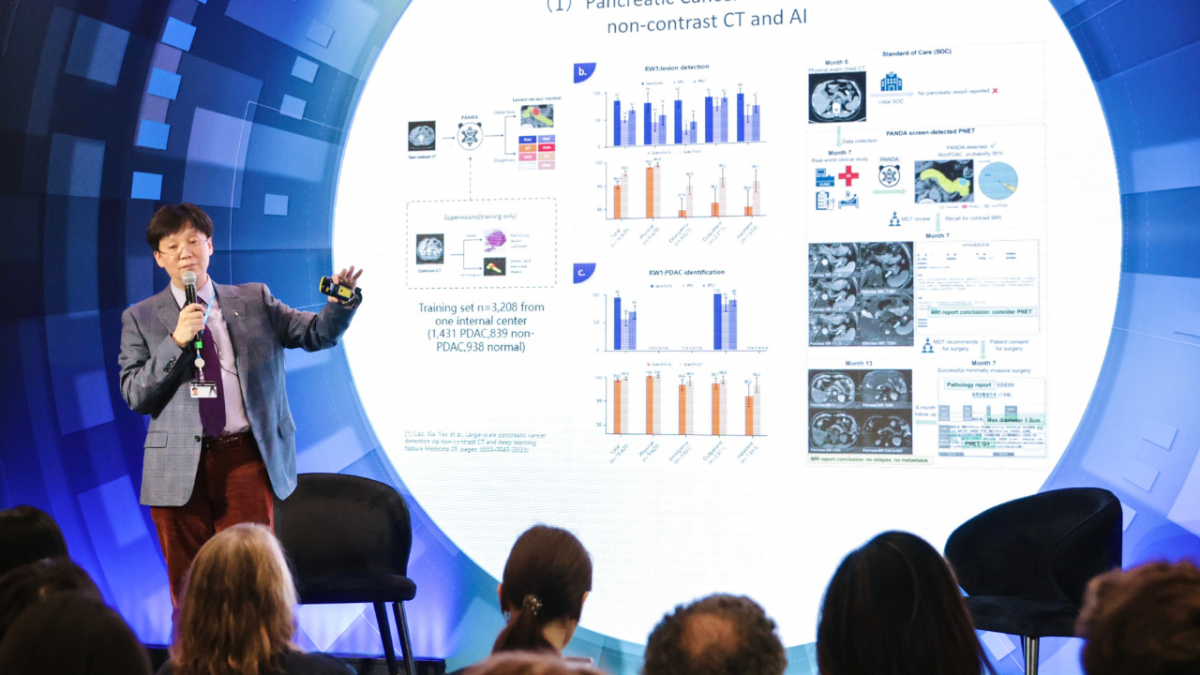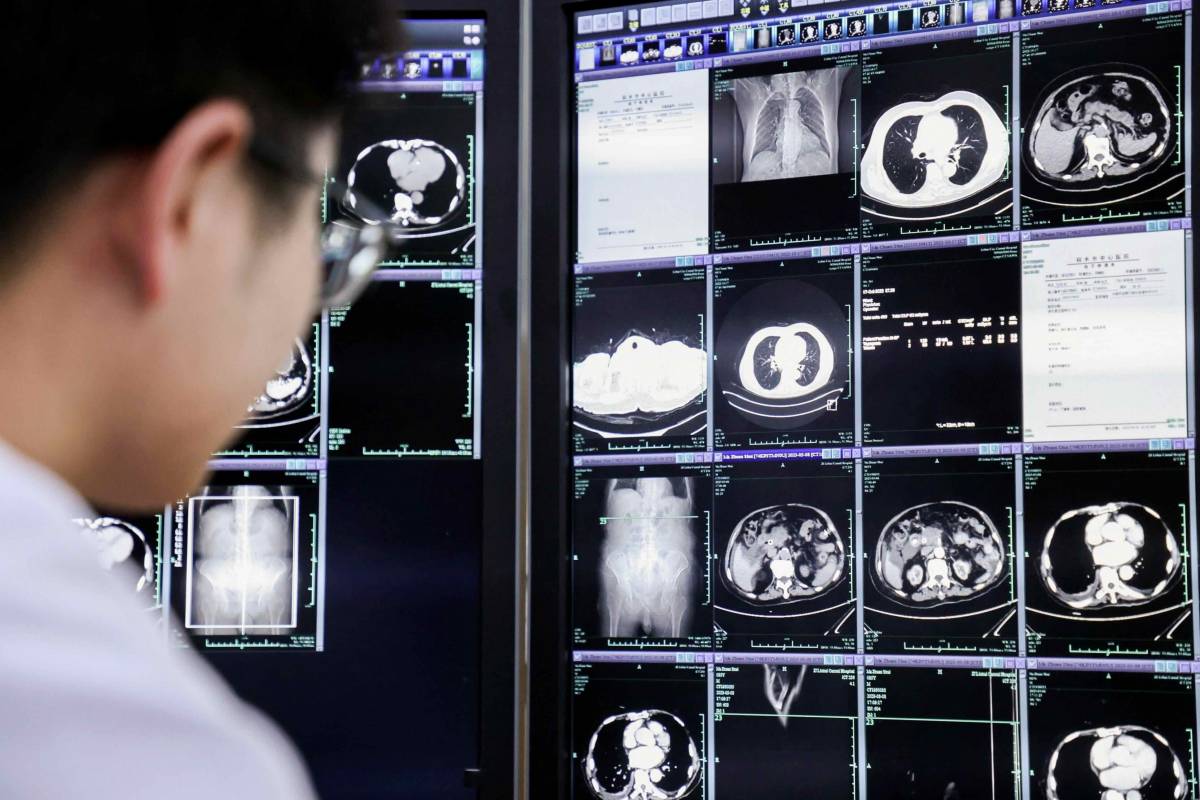


Dr. Le Lu, head of DAMO Academy's medical AI team, speaks at the AI for Good Global Summit on May 30, 2024. Photo credit: Alibaba Group
When it comes to cancer, early detection can mean the difference between life and death – but getting a screening is easier said than done in many regions with limited healthcare.
Artificial intelligence is leveling the playing field.
Alibaba Group’s research institute DAMO Academy has developed a breakthrough AI-powered tool to screen body scans for some of the most fatal types of cancer.
It’s a quick and low-cost solution to a growing problem: by 2050, global cancer diagnoses will top 35 million, the World Health Organization (WHO) estimates.
And soon, more people will be able to access this resource, thanks to a strategic partnership between DAMO Academy and the WHO Collaborating Center on Digital Health.
“The goal is to provide affordable and convenient screening options without sacrificing quality,” Dr. Le Lu, head of DAMO’s medical AI team, told Alizila ahead of the United Nations’ AI for Good Global Summit.
On the eve of the annual event in Geneva, we caught up with Lu to delve into AI’s transformative potential in cancer detection and the fight to save lives.
The following conversation has been edited for brevity and clarity
Q: At DAMO Academy, how do you leverage AI technology to address some of the world’s toughest challenges in health?
A: About a decade ago, deep learning was not universally recognized for its potential in medical applications. We decided to explore its use by focusing on one of the most difficult organs for conventional computational methods at that time– the pancreas.
Pancreatic cancer is one of the deadliest cancers in the world and it’s one of the most challenging cancers to diagnose and treat. Its complexity is compounded by the difficulty of pancreatic segmentation in medical imaging.
At DAMO Academy, we developed an AI-powered tool called pancreatic cancer detection with artificial intelligence that can screen for early signs of pancreatic cancer. The deep learning-based model is able to detect cancerous and pre-cancer lesions in the pancreas by examining non-contrast CT scans, a more efficient form of medical imaging used worldwide with a lower dose of radiation than contrast CT scans.
So far, we’ve achieved significant progress in the early detection of seven common cancers through a single non-contrast body CT scan, including pancreatic cancer, esophageal cancer, lung cancer, breast cancer, liver cancer, gastric cancer and colorectal cancer.
Other than early detection, the other area we’ve achieved progress is accurate and early differential diagnosis. Knowing the specific subtypes of cancer is vital because each subtype may require a different treatment plan and follow-up workflow. Our goal is to leverage AI to cover the entire process of cancer treatment – from early detection to diagnosis with great precision and accessibility.
Q: What are some of the major challenges you’ve encountered and how did you manage to cope with the challenges?
A: The most significant challenge is to achieve high accuracy in cancer identification by leveraging the AI models, and to make them accessible for patients to use. The goal is to provide affordable and convenient screening options without sacrificing quality.
This is why instead of having the patient go through contrast-enhanced CT scan, we leverage AI tool to aid doctors in screening and diagnosis by analyzing existing CT scans taken from various scenarios, including physical examination, emergency, inpatient, and outpatient department.
If a patient undergoes a CT scan for chest issues, for example, the idea is to utilize that scan to simultaneously screen for other primary cancers in the region, to get more value out of a single imaging procedure. There’s potential in the future to use these AI tools as a routine part of health screenings for asymptomatic individuals to identify early signs of cancer.
Q: How has the technology been applied in clinical settings in real-life scenarios?
A: Pancreatic cancer detection with artificial intelligence, the AI model we proposed, is capable of detecting and classifying pancreatic lesions in CT scans. It surpassed the average radiologist in sensitivity by 34.1% and in specificity by 6.3% in validation test.
We trained the model on a training set of abdominal non-contrast CT scans of 3,208 patients from a high-volume pancreatic cancer institution to achieve the high sensitivity and specificity rate. In a large-scale, real-world test involving approximately 20,000 patients, PANDA achieved a sensitivity of 92.9% and a specificity of 99.9%. While running the tests, PANDA detected pathological changes as a result of pancreatic cancer in 31 patients that doctors had missed.



We’ve applied this technology in prospective real-life clinical settings for in-patients and emergency department patients at two hospitals in Lishui city in China’s Zhejiang province.
The project first focused on the early screening for pancreatic cancer and osteoporosis, and gradually expanded to include screening for liver cancer, esophageal cancer, gastric cancer, colon cancer, fatty liver, and other chronic diseases.
Q: What’s the implication of the AI screening technology for human radiologists?
A: There’re medical conditions that are challenging for the human eye to detect during standard non-contrast CT scans. Leveraging AI to conduct a first viewing can significantly improve the early detection of lesions. AI can highlight potential issues for further evaluation, which might otherwise be missed even by experienced doctors.
After the AI has done its initial reading, it is essential for a medical professional to review and verify the findings carefully. Once AI has spotted a potential tumor, additional enhanced scans (such as an CT scan with contrast) are required for accurate diagnosis and planning for appropriate treatment.
AI does not compete with doctors but rather enhances their ability to diagnose accurately by pre-screening and flagging areas of concern. It handles tasks that are hard for humans to do efficiently, serving as a complement to a physician’s capabilities.
Q: What are some upcoming collaboration projects that you can share? Is your lab working with other institutes to maximize the values of AI research for the global health community?
A: During the AI for Good Summit, we reached a strategic partnership with the WHO Collaborating Center on Digital Health to advance innovations on digital health and bring the benefits of medical AI to more developing countries.
We’re also working with some of the largest health checkup organizations in China to advance cancer screening initiatives as part of the regular health checkup. By incorporating cancer screening into the standard screening procedure, we can increase efficiency and potentially reduce the cost and burden on patients.
Our cloud-based solution empowers patients who might not have access to cancer screening due to the scarcity or high costs associated with expert medical care. We’ve by far provided over six million screenings in China.
This high volume reflects the demand for healthcare screenings and the potential scalability of the service. We’ll continue to leverage technology and strategic partnerships as such to make healthcare services more accessible, comprehensive, accurate and efficient.





